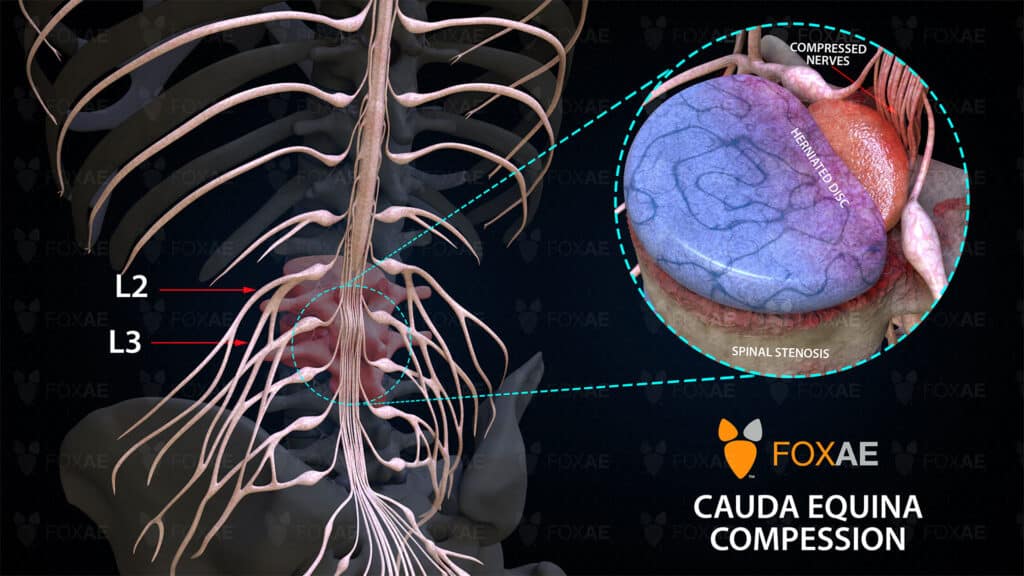The American Association of Neurological Surgeons has described this type of nerve compression as Cauda Equina Syndrome.
An explanation given by AANS says that “the collection of nerves at the end of the spinal cord is known as the cauda equina, due to its resemblance to a horse’s tail. The spinal cord ends at the upper portion of the lumbar (lower back) spine. The individual nerve roots at the end of the spinal cord that provide motor and sensory function to the legs and the bladder continue along in the spinal canal. The cauda equina is the continuation of these nerve roots in the lumbar and sacral region. These nerves send and receive messages to and from the lower limbs and pelvic organs.
Cauda equina syndrome (CES) occurs when there is dysfunction of multiple lumbar and sacral nerve roots of the cauda equina.”
What Causes Cauda Equina Syndrome?
According to the AANS, there can be multiple causes for Cauda Equina Compression.
CES most commonly results from a massive herniated disc in the lumbar region. A single excessive strain or injury may cause a herniated disc, however, many disc herniations do not necessarily have an identified cause. The size of the disc herniation that results in cauda equina is often much larger than normal; however, if the spinal canal is smaller due to conditions such as arthritis, a smaller disc herniation can produce CES.
Potential Causes of CES
- Spinal lesions and tumors
- Spinal infections or inflammation
- Lumbar spinal stenosis
- Violent injuries to the lower back (gunshots, falls, auto accidents)
- Birth abnormalities
- Spinal arteriovenous malformations (AVMs)
- Spinal hemorrhages (subarachnoid, subdural, epidural)
- Postoperative lumbar spine surgery complications
- Spinal anesthesia
Medical Exhibits
Most of modern society receives their information via visual and written media, if not exclusively visual. For some people, this extends to learning to the extent that the only way the person can learn is if they’re able to see it with their eyes. This presents a problem for the way most trials transpire. At least a few members of the jury are likely to consider themselves visual learners and will struggle to keep up with the vast amounts of complex information that’s being presented.
The best solution to this problem is to include a visual aid. Allan Barsky said in his book, Clinicians in Court:
“As noted throughout this volume, the purpose of providing evidence at a trial is to educate the judge or jury about the facts in a case. As the saying goes, “Seeing is believing,” so using visual aids in courtroom presentations can have a critical impact on the decision makers. Seeing a torn piece of clothes may be more convincing than just hearing about it.”
Barsky, A. (2012). Clinicians in Court (2nd ed.). The Guilford Press
Medical Animation
Our cutting-edge animation technology paired with some of the most talented medical experts in the country has allowed us to become industry leaders in creating medical illustrations. We have a team of certified medical illustrators, medical practitioners, and 3D modeling engineers that can recreate any kind of surgery or injury in astonishing detail.
We’ve worked with some of the top attorneys and expert witnesses in the country, and have produced animations so precise, that they have been admitted as substantive evidence, not just demonstrative. A neutral expert witness in a particularly challenging case testified that our animation was exactly what he saw when he performed surgery on the plaintiff after the defendant misdiagnosed the plaintiff.
Medical Imaging Modeled in 3D with Perfection
“Over 2 decades I have used several animation firms nationwide to prepare medical animations based upon diagnostic imaging, e.g., x-rays, CT’s, and MRI’s. The work product was always acceptable, but never up to state-of-the-art standards for cutting-edge animation – until now.
I reached out to Fox-AE after receiving an email from their Marketing Director. The email included a link to an exemplar animation. After viewing the animation, I knew that I wanted to give Fox-AE a chance. I arranged to have the Fox-AE animation engineer fly in to meet our neuroradiology expert and review the MRI together. From there, the engineer worked with the expert to ensure that the animation was an exact match with the MRI. The result was stunning in every respect. The precision with which the animator accurately captured the MRI was without peer. Every person who has seen the animation is struck by its detail and flow. First-rate in every respect. Use Fox-AE whenever possible – your client and the jury will thank you. Opposing counsel will not.”
Stephen Malouf
Malouf & Nockels, LLP
Fox Animation Engineering - Industry Leader for Legal Graphics
The overwhelming satisfaction of our clients is living proof that we’re the best in the business for animated engineering. Ultimately, we’re here to streamline the information transfer process from you to the jury. No matter the kind of injury or the circumstances surrounding the incident, we can render a compelling representation that will leave your audience stunned.



